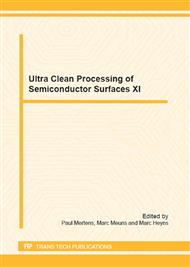p.161
p.165
p.169
p.173
p.177
p.181
p.185
p.191
p.195
Influence of Dissolved CO2 on Bubble Activity in Pulsed Acoustic Fields
Abstract:
The continuous miniaturization of electronic building blocks in the semiconductor industry imposes more stringent requirements on the different cleaning processes. Purely chemical particle cleaning is based on weak etching of the substrate. This etching reduces the attractive van de Waals interaction between particle and substrate and at the same time, electrostatic repulsion ensures the removal of particles. This technique is not applicable anymore for future technology nodes, since an unacceptable large substrate loss (up to 3 nm) is necessary to obtain high particle removal efficiencies with pure chemical cleaning alone [. As a result, an additional physical force has to be considered to overcome this limitation. Several physical cleaning techniques exist, but all of them suffer from too much damage creation when fragile structures are cleaned. Currently, the industry is more focusing on spray cleaning and state-of-the-art spray tools show a high control over droplet size and droplet velocity [2]. Despite all of the advancements in spray cleaning, damage creation of fragile elements remains an issue, which could partially be attributed to the chaotic behavior of the water layer on the wafer surface [3]. Therefore, megasonic cleaning is still considered as a possible alternative to reduce damage formation during a physical cleaning process. Recently, it has been shown that the acoustic pressure amplitude can be reduced while maintaining the same particle removal efficiency level. This is achieved by (1) using pulsed acoustic fields which makes it possible to control the average bubble size and maximize the number of resonant bubbles, by (2) increasing the dissolved gas concentration which facilitates bubble nucleation and, finally, by (3) introducing traveling waves to transport bubbles to the wafer surface which needs to be cleaned. These conditions are briefly discussed and are applied during the investigation of the influence of dissolved CO2 on bubble activity. Dissolved CO2 is particularly interesting since it has been reported that sonoluminescence (i.e. strong bubble collapse) as well as damage formation is reduced when CO2 is added to the cleaning liquid [4,5]. Here, it is shown that also particle removal efficiencies (PREs) diminish with increasing CO2 concentrations.
Info:
Periodical:
Pages:
177-180
Citation:
Online since:
December 2012
Price:
Сopyright:
© 2013 Trans Tech Publications Ltd. All Rights Reserved
Share:
Citation:


